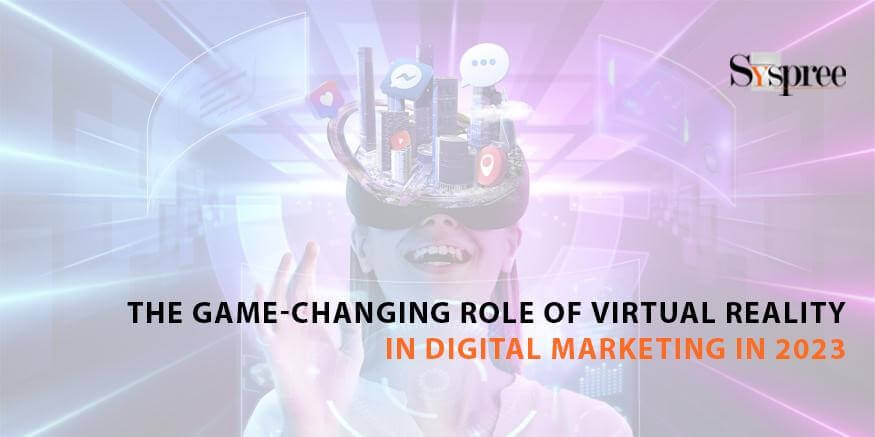Technology is getting more advanced, as are the expectations of consumers. This is why more is needed to make them feel engaged and keep them engaged. You also need to exceed their expectations. This is why you must look into incorporating augmented realities (AR) as well as Virtual Realities (VR) in the marketing strategy you employ.
Let’s look at each definition, some examples of brands making the right choice, and whether small companies can participate.
The marketing strategies are available in a variety of kinds and sizes. Still, most of them share an underlying theme: the need to catch people’s attention and provide them with something they’ve not seen before. Technology is a major factor because it not only aids in creating content for marketing campaigns but can also deliver it to people. VR is the ideal medium to accomplish this.
The best web development company states that although VR has been used in entertainment and games for a long time, it has also been found to have numerous applications in different sectors. In fact, in 2023, companies are predicted to comprise half of VR users, and marketing will become a major subject. In this article, we’ll look at the role of Virtual Reality in marketing and ways to make VR a part of your marketing plan.
What is Virtual Reality Marketing?

Virtual Reality Marketing
Simply put, the definition of virtual reality marketing is an effective marketing method that integrates technology that is virtual reality in marketing campaigns. It is a way to interact with your target audience and improve brand engagement. For example, instead of viewers reading text on their screens, they can interact with a virtual character.
It is referred to as immersive media and virtual reality; augmented reality marketing presents several opportunities for companies to advertise their brands, boost sales, and increase the retention of customers and their loyalty.
Virtual reality is a realistic, immersive environment that engages various senses. Users have access to VR headsets or apps. For instance, VR overlaps a filter on an image or video. Allow a leading digital marketing agency to make use of VR marketing.
Imagine Instagram or Snapchat filters. Additionally, VR headsets can “transport” users into the 3D virtual world, increasing the immersive experience. The headset responds to the user’s movements and allows users to take a full perspective of the virtual space (360-degree viewpoint) and interact with different digital elements of the simulation.
How to Use VR in Marketing?
The apps that create immersive experiences can be designed with various applications and numerous VR market segments. For instance, you could make use of VR in B2B marketing.
Virtual Reality (VR) is fast becoming an effective instrument to help digital marketing. A leading company offering web design and web development services in Mumbai can guide you about VR marketing.
With its ability to create an interactive and immersive experience, VR can change how brands communicate with their target audience. In this blog, we’ll look at how you can utilize VR in your marketing and the advantages it can offer your business.
1. Customers can “Try before they buy.”

Try before they buy
On the heels of Sephora’s success, other brands are embracing augmented reality marketing, which allows customers to try their products in a virtual environment before purchasing them. It gives customers a complete view of the product, which makes it less likely for them to want to return the item.
We know that 64% of all e-commerce returns happen because the item isn’t up to the customers’ expectations. Lower returns translate to lower expenses and more income for your company. Also, less waste will be generated from products that can’t be reused.
Businesses are profiting from this technology already. According to Deloitte, augmented reality marketing is proving to be successful and has a positive return on investment in a number of industries, including those selling shoes, beauty, and furniture.
2. Simulation:
The first step is to comprehend Virtual Reality’s concept and how it differs from other types of digital media. VR can be described as a computer-generated representation of a 3-dimensional world that can be manipulated using special hardware like VR headsets. VR headset.
The best digital marketing agency in Singapore believes that the technology lets users completely immerse themselves in an immersive virtual world. It creates an experience that’s more enjoyable and memorable as compared to traditional 2D media.
3. Virtual tours:
One of the major advantages of VR for marketing is its capacity to create interactive and immersive brand experiences. Companies can use Virtual Reality to lead their consumers through immersive tours of their goods and give them a complete understanding of the products they’re purchasing.
For instance, a vehicle manufacturer could use VR to allow customers to test drive one of their vehicles. Or, the home builder could use VR to offer customers the opportunity to experience a virtual tour of their new product.
4. E-commerce:
Another area in which VR has made a huge impact is e-commerce. With the help of VR, online retailers can provide customers with a more authentic and enjoyable shopping experience.
For example, furniture dealers could use VR to show customers how furniture will look in their homes, and fashion stores can utilize Virtual Reality to let customers virtually try on clothes.
5. Virtual Events:

Virtual Events
VR is also used in marketing events to design virtual trade shows and events. This makes brands more accessible to a wider audience because virtual events can be accessed from anywhere around the globe. VR events also offer the benefit of being greener and more cost effective than traditional events. Let a web development company assist you in incorporating VR for events.
6. Simulations of workplace environments:
Another place in which VR can be utilized is for employee training and demonstrations of products. VR can create realistic virtual simulations of workplace environments and procedures, allowing employees to exercise in secure and controlled surroundings. It is also a way to make virtual demonstrations of products to give the customers a better understanding of how they function.
7. Virtual Reality in mobile devices:
The potential of VR in marketing via digital channels looks promising, with many experts anticipating that it will soon become an increasingly crucial tool for businesses seeking to engage with their target audience.
The trends worth looking out for are that of using VR for personalization, integrating VR into other technologies, such as artificial intelligence, and the growing use of VR on mobile devices.
Virtual reality can transform how brands interact with their customers. Creating engaging content in VR could make brands stand out in an increasingly crowded digital world. As technology develops, companies must be aware and prepared to make the most of the opportunities VR can provide.
8. Branded games:
Branded games effectively raise the brand’s visibility and introduce customers to your brand in a relaxed and enjoyable manner. While players focus on the game, they have exposed images of a brand or its product.
9. Content marketing
VR can be used for effective content marketing. VR is efficient because it is among the available visualization tools. 3-D images, models, animations, and texts become more engaging and clear when presented using the headset. A leading digital marketing agency can help you use VR efficiently in content marketing.
The Advantages of Marketing with Virtual Reality
-
It impresses clients and users
VR is an attractive technology that certainly makes an impression. People are always eager to try new technology and usually enter an immersive experience with positive expectations. This allows you to impress people with your product or service and then imprint it on their minds.
-
Facilitates greater interaction between product and user
Interacting with something using VR is a fantastic way to understand how it functions. An immersive application is just as effective at informing your customers about your services as the physical product. In addition, if you can make it enjoyable and engaging, you could create an emotional connection between the user and the product.
-
Easy to deploy campaigns
The only items you require to provide a VR experience to someone are a headset and an application. When we’re discussing in-person access to meetings, workplace facilities, and more.
It is also possible to offer the app online for existing VR customers to download and experience it remotely. Find the best web design and web development services in Mumbai to get assistance in deploying VR campaigns.
-
Reduces the burden of sales teams.
In addition to showcasing a product or service, you can utilize VR as a tool for sales that allows customers to quickly change from studying and looking at the item to placing an order. This satisfying and practical experience will drastically reduce the number of requests sent to sales reps.
What is the Difference Between Virtual Reality and Augmented Reality?

Difference Between Virtual Reality and Augmented Reality
There is a certain similarity between Augmented Reality (AR) and VR. Both have the same characteristics of being “virtual .”There are differences in the methods of use and the possible business applications. In short, AR takes an existing experience and enhances it.
VR creates an immersive experience. VR’s applications to businesses are vast and profound in our lives. We are seeing AR being utilized on everyday phones and tools like GPS and cameras.
The main benefit is that most consumers already have the needed equipment, making certain AR applications appropriate for consumer products, retail experiences, and entertainment.
Future of VR in Digital Marketing: Trends and Forecast
Virtual reality’s future (VR) in the field of digital marketing appears promising, with many experts anticipating that it will be an increasingly vital tool for companies looking to engage with their customers.
One trend that is likely to remain the same in the coming years is using VR for personalization. With VR tech becoming increasingly readily available, it will allow brands to design personalized experiences for their clients based on their needs and preferences.
For instance, a fashion retailer could let customers virtually try on clothes, and a travel agency could use VR to provide customers with an immersive trip through their ideal vacation spot.
Another area likely to grow in popularity includes the integration of VR alongside other technologies, such as artificial intelligence (AI) or the Internet of Things (IoT). As VR gets more advanced, it can interact with other systems and devices effortlessly and intuitively.
A home builder might use VR to show customers an immersive tour of their new construction and also use IoT to regulate the temperature and lighting of the virtual house. The best digital marketing agency in Singapore believes that the increasing usage of VR on mobile devices is expected to become a significant factor in the near future of marketing via digital.
As VR becomes more commonplace and accessible, brands will be able to reach out to a larger market by creating VR experiences that are available on tablets and smartphones. This will enable brands to interact with their clients much more personally, regardless of geographical location. Alongside these trends, experts believe that VR will play an important role in the evolution of new technologies, such as AR (AR) as well as mixed reality (MR).
As VR technology gets more sophisticated and advanced, it can seamlessly connect with other technologies in order to provide more immersive and engaging experiences for customers. VR could transform the way brands communicate with their target audience.
The technology of VR continues to advance and develop, and it will alter how brands interact with their customers. It will also create new opportunities for brands to stand out in an increasingly crowded digital world. Brands that stay up-to-date and make the most of the opportunities VR can provide will be prepared to thrive in the new digital marketing world of the near future.
Conclusion:
In the end, the use that virtual reality plays in digital marketing is increasingly crucial as it enables brands to create engaging and interactive experiences for their clients. Through virtual tours and product demos to virtual events and training for employees, VR can transform how brands communicate with their customers.
Brands that keep current and take advantage of VR’s opportunities will be ready to prosper in the upcoming digital market environment. If you enjoyed this blog article, you’ll undoubtedly enjoy the one before it on 7 Crucial Steps to Create an Effective Customer Journey Map For Your Business.








Nice Share. Thanks for Sharing
Thank you for sharing such knowledgeable content on VR in digital marketing. Really informative!
Thank you for your kind words
This is a fantastic blog on the role of virtual reality in digital marketing. I love reading your blogs they are effortless to understand. Keep sharing such wonderful blogs.
We are pleased to know you found the blog useful
An interesting article discussing the expanding significance of virtual reality in digital marketing techniques, “Role of Virtual Reality in Digital Marketing” It offers useful information on how organizations can make use of virtual reality for marketing objectives.
Thank you for your positive feedback! We’re thrilled to hear that you found our article on the role of virtual reality in digital marketing informative and interesting